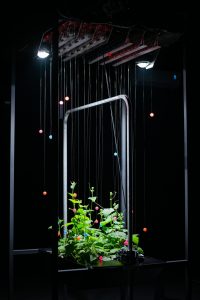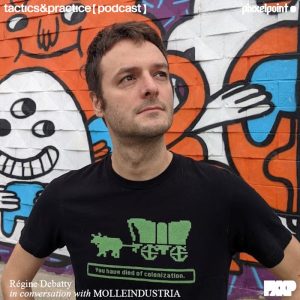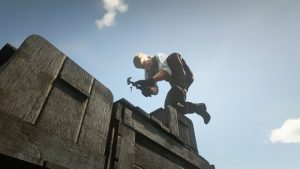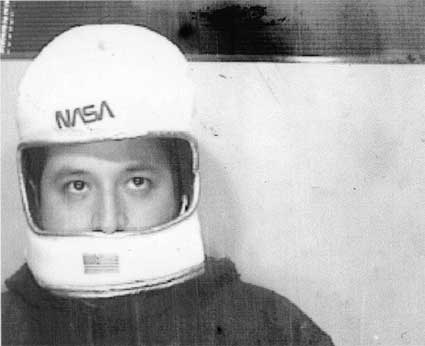
I’ve discovered Fernando Orellana in 2004, the year i realized that there were artists playing with technology out there. All along my tumultuous and whimsical 4-year relationship with new media art, artists have been appearing and disappearing from my BVBMA (Best of the very best media artists) list. I’m slowly moving away from the entertaining, the merely playful, the very geeky, the strictly techy and i’m now looking for something called “an artistic experience”. Well, Fernando’s installations are quite geeky in a sense and some are even playful but, no matter how you define art, i’ve always found something extremely meaningful and touching in Fernando’s work: a robot dreams, others are unable to make a decision, an elevator appears to be self-aware and a vintage radio relentlessly searches for God. Needless to say, Fernando’s work has always amazed me and i can see in my crystal ball that it’s going to be that way for the years to come.
The artist has uploaded several videos about his work on you tube. As a starter, here’s an ABC news segment on his robotic art piece “Sleep Waking”:
When i first met you in Gijon at the opening of the exhibition Emergentes, you told me about the personal story behind 8520 S.W. 27th Pl. v.2 (don’t miss the video of the robot assembly), an installation about the pointlessness of our never ending decision making process. Can you share it with the readers?
8520 S.W. 27th Place is the address of the home I grew up in Davie, Florida after my family moved from El Salvador in 1979. It is in a housing development called Rolling Hills. I’ve linked it in Google maps.
For the most part, my siblings and I assimilated and became part of American culture. Subsequently we grew up in the burgeoning suburban sprawl that has now swallowed southern Florida into an endless ghetto of cookie-cutter dream homes. This is what frames a large portion my childhood memories. Neatly cut lawns. Driveways with two-car garages. Manicured gardens adorned with transplanted trees. Swimming pool parties. Mosquito nets. Packaged people living out their packaged lives. Day in. Day out.
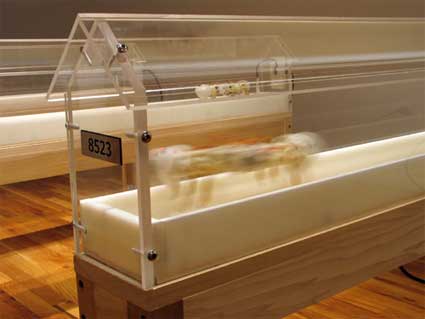 8520 S.W. 27th Place, 2004
8520 S.W. 27th Place, 2004
This imagery is what fueled the aesthetic for this 8520 S.W. 27th Place. I wanted to reference the suburban dwelling that millions of other people worldwide grew up in as well. I thought it this would be the appropriate stage for a sculpture that speaks of humanities’ decision-making process. It is within the walls of these prefabricated, automated homes that we ceaselessly make decisions about everything; from the type of partners we want, to the garnishing on our pizza delivery, to what color we want our IPods. Endlessly. Back and forth. From the moment we are born till the day we die.
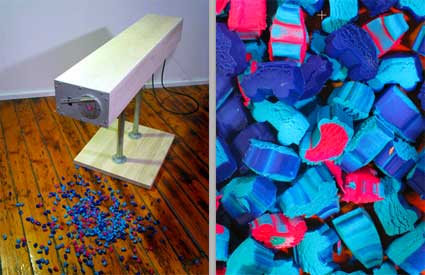 Extruder, 2008
Extruder, 2008
How did you come up with Extruder? Where did you get the idea of making a machine that makes play-doh cars?
I arrived at the idea for Extruder from a couple different places. It branches from a series of drawing machines that I made a couple years back. Extruder started because I wanted to make a machine that could make sculpture. I had been doodling designs for this mechanism for years. I suppose funding issues kept them from materializing until now.
This last summer I made a series of paintings that spoke of war, dismemberment, IEDs, and automobiles. During that process, I came to appreciate the impact that the automobile has made on this world. I read a statistic that still baffles me when I think about it now. There is one car for every 11 people in this world, roughly 590 million passenger cars total. The automobile is involved in everything. From pancakes to penicillin, Play-Doh to parking lots.
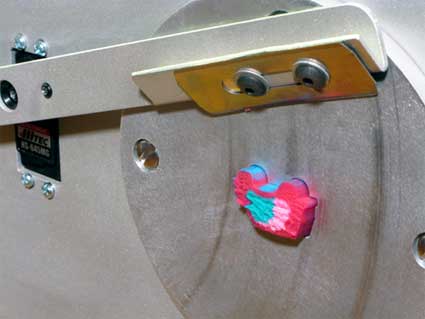 Extruder, 2008
Extruder, 2008
I developed Extruder as a response to this machine that we worship. I wanted to celebrate it. Criticize it. Emulate it. Making hundreds of Play-Doh cars. Millions. The ultimate goal of Extruder is to make the total number of automobiles that were made in 1947 (the year Henry Ford died) by the Ford motor company, an estimated 429,674. As you can imagine that is also a whole lot of Play-Doh; about 11 tons. Until May 11th 2008, Extruder will be making Play-Doh cars at the Mandeville Gallery at Union College in Schenectady, NY. When the next venue emerges to exhibit it, the process will continue.
The colors that Play-Doh comes in were also a nice reference to my recent paintings. Vivid primaries and secondaries, suggesting the Technicolor cartoon reality that we in the developed world live in. Entertainment for the masses, delivered in candy-wrapped doses of violence, humor, and erotica.
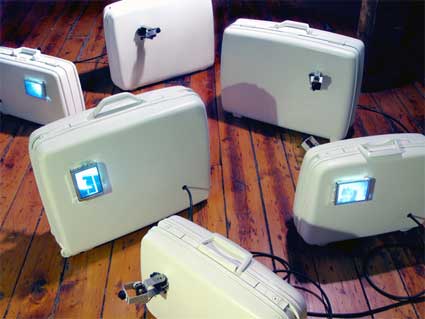 Carry On
Carry On
The Carry On installation features a series of suitcases fitted with robotic arms and micro-cameras which survey their surroundings. Why did you feel the necessity to develop a work that explores surveillance and paranoia? How much impact on the public can artists have when they comment on surveillance technology?
Carry On is a direct reaction to post-September 11th paranoia, both in the USA and abroad. Since the attacks, I have traveled quite a bit. On these trips, I have passed through countless security and surveillance systems, always hunting for the would-be terrorist. Subway cars now display and sometimes speak “Report ANY Suspicious Activity”. If you happen to look even slightly of Arab descent, you may think twice about growing a beard or wearing your traditional garb. Leaving your luggage or backpack alone in an airport or a train station, even for a moment, could lead to a cavity search.
Holding a miniature video camera, on one side of each suitcase in Carry On is mounted a two axis robotic arm. The live video feed from this camera is displayed on a LCD screen mounted on the other side of the suitcase. Every couple of minutes, the robots change the position of the cameras, thus changing what is being displayed in the LCD screens. Lacking image analysis of any kind or other sensory capability, these suitcases blindly look about, never understanding what they see.
I’m not sure what impact artists make when they reference surveillance technology. Perhaps it may give a person a moment of peace or clarity. Realizing that, like the artwork in front of them, the whole affair of paranoia and fear based politics is an illusion; clever clockwork designed to create the reality they want us to believe in.
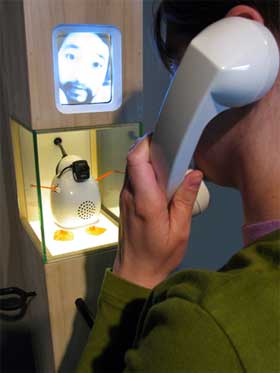 I saw that images of one of your recent project, Phoney. What is the work about?
I saw that images of one of your recent project, Phoney. What is the work about?
Phoney is a toy. It is a kind of absurd videophone. There are two terminals to the piece. The terminals are installed in separate parts of a gallery, with no line of site between them. Each terminal is fit with an old-school telephone receiver, a video screen, and a black and white camera attached to the head of a modified mechanical toy. When a person speaks into the telephone receiver of one terminal, their voice makes the mechanical toy on other terminal dance. This causes the video image they are looking at to shake, since the camera on the other side is attached to the mechanical toy. If two people are involved, a bizarre and sometimes funny conversation can commence. To me the piece references the countless methods or proxies that we now communicate through and the ridiculous information that we pass through them.
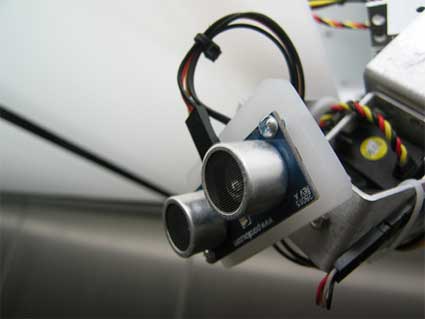 Elevator’s Music, 2007
Elevator’s Music, 2007
I read that your work is about “creating systems that seem to be alive”. How much life is there really in your artworks? and how would you define such kind of life?
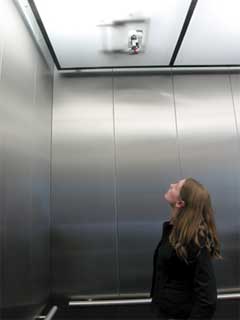 The key part in the quote above is this: “seem to be alive”. My machines are not alive. They never will be. I have become much more interested in the simulation of living systems. It is remarkable how easily we anthropomorphize things, especially things that are in motion. The perception of what humans will assume or believe to be alive is where much of my robotic work is headed.
The key part in the quote above is this: “seem to be alive”. My machines are not alive. They never will be. I have become much more interested in the simulation of living systems. It is remarkable how easily we anthropomorphize things, especially things that are in motion. The perception of what humans will assume or believe to be alive is where much of my robotic work is headed.
The latest iteration of this investigation is Elevator’s Music, a site-specific robotic sculpture that I exhibited in an elevator at the Tang Museum in Saratoga Springs, NY in the winter of 2007. It consisted of four small robots that emerged from the elevators translucent ceiling panels. When people entered the elevator, the robots would sense them and might emerge. Fitted with sonic sensors and having the ability to maneuver in three axes, they were programmed to seek out and respond to near and far objects. If a robot found something near by, it would try and interact with it via randomly determined mechanical gestures and a watery stream of sounds. The robot would also send a message to the other three robots (through a local network), informing them that it had found something of interest. This would cause all robots to look in the direction of the object, causing a kind of musical symphony to commence. If the object was somehow to close, or if nothing was found, they would recoil back into the safety of their ceiling panels.
With this relatively simple set of instructions the elevator robots were able to illicit innumerous reactions from their passengers. Some believed that the robots were watching them or trying to attack them in some way, while others became enamored with them, whistling and talking to them like one would to a pet bird. When one of the robots failed (as all robots eventually do), passengers reported it immediately to museum officials, feeling empathy for the hurt machine. Future robotic sculptures that I design will foster this tendency to assign anthropomorphic qualities to inanimate objects. Through this investigation I hope to arrive at more sophisticated and realistic artificial life simulations.
Video of “Elevator’s Music” at the Tang Teaching Museum at Skidmore College in Saratoga Spring, NY
What can technology developers or scientists learn from digital artists like you? Is there any reason why they should pay more attention to what crazy artists are doing?
I like to think they should pay more attention. In this country there is a general undervaluing of fine art and art education. Art departments all over the nation are the first to suffer from severe budget cuts. The argument that art is not a “mission critical” subject has dominated the establishment for decades. The problem with this of course is that students become completely illiterate to the visual culture all around them. In engineering and science I think this becomes a handicap. The engineer or scientist that can beautifully communicate their findings will undoubtedly fair better on the world stage. Moreover, those engineers or scientists that are willing to experiment with ideas that seem pointless or ridiculous may arrive at discoveries, innovations, and conclusions that otherwise might have eluded them. Perhaps “crazy artists” do have something to teach, other then just being dismissed to be irrelevant or a waste of time.
What is your favorite gadget or bit of technology and why?
It would have to be my laptop. I basically live inside it (or through it?). That aside, I have to say that I am a huge space technology nerd. I read everything and anything about space. Spirit and Opportunity, the two rovers scooting along on mars, or Voyagers one and two, speeding out of the solar system at this very moment are like aphrodisiacs to me. In fact I have a number of art projects that I am just waiting to develop specifically to be put into zero-g environments. Hopefully by the time I am retiring, this will be a possibility! In classic nerd style however, I would first need to over come the crippling and ridiculous sea-sickness I suffer from, sometimes even on sea-side docks.
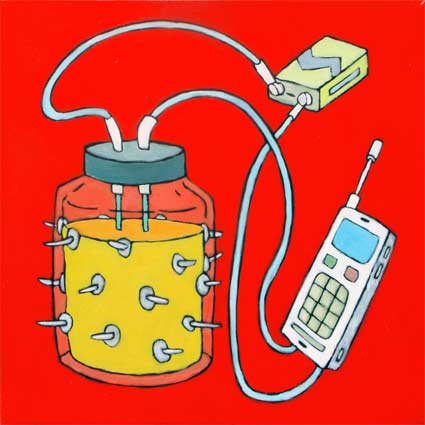 Nail Jar, 2007
Nail Jar, 2007
What are the common factors between your media art installations and your paintings? Or maybe they have nothing to do with one another?
Painting and drawing is something I have always done. It was my doorway into art and in many ways it keeps me balanced. Until recently, the subjects I painted came from the schools of dada or surrealism, seemingly from my subconscious. This all changed in my recent work. Without really knowing why, last summer I started tackling the subjects I was exploring in my electronic sculptures in the paintings. Painting allows me to quickly approach different angles or points of view within a subject, some of which would not be possible in media sculptures due to funding or physical limitations. It is also a way for me to quickly explore new ideas, some of which are now leaving the canvas surface and becoming sculptures.
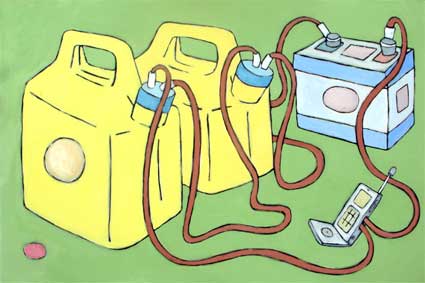 Gasoline, 2007
Gasoline, 2007
You are also developing an electronic art program at Union College in Schenectady, NY. Can you tell us what the highlights of the program are?
I was hired three years ago to help start an electronic art program at Union College. Our program is one of the few electronic arts initiatives that is jointly sponsored between the Computer Science and Visual Arts Departments. Drawing from aspects of The School of the Art Institute of Chicago and The Ohio State University’s Art and Technology programs (both of which I graduated from), we have created a thorough course of study, covering topics in digital imaging, video, 3D modeling, physical computing, experimental computer programming, web-design, interactivity, and animation. We have worked hard to make the program as cross-disciplinary as possible, offering courses that computer science, fine-art, and students from other disciplines can benefit from. In many ways the program was a perfect fit at Union College, since it has a long tradition of combining world-renowned engineering within a equally solid liberal arts education.
Any upcoming project or event you could share with us?
There are a couple projects cooking. The most imminent is a real-time video series titled Plain Text. The series plays on the “infinite monkey theorem” which states that given an infinite amount of monkeys, typewriters, and time, the monkeys will type out any particularly text you choose. If one instructs the monkeys (or monkey simulators), to type the King James Bible one of them eventually will. Interestingly, this also includes all the text that you did not choose or any text that might ever be written.
I apply a version of this theorem to a series of short phrases that over an extended period of time cycle through every possible permutation of themselves. For example the phrase:
“You want _ _ _ _ _ _.”
Starting right-to-left, like an odometer only with letters, all the blank spaces in the phrase sequentially cycle through every letter in the alphabet. By this, every word that is six characters long will eventually appear in the phrase above. Differing in theme, amount of blank spaces, and speed, each piece in the series has a different phrase displayed by itself on a large LCD screen.
 For the PluggedIn Exhibition happening in Hudson, NY from May 17th – 30th, two of these phrases will be on display in the vestibules of the Mark McDonald store, along with one large phrase projected on the store’s second floor windows.
For the PluggedIn Exhibition happening in Hudson, NY from May 17th – 30th, two of these phrases will be on display in the vestibules of the Mark McDonald store, along with one large phrase projected on the store’s second floor windows.
Thanks Fernando!


